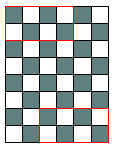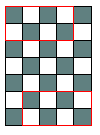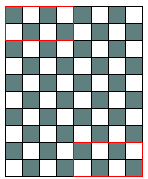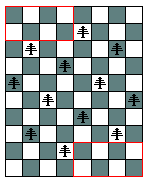StrataChess v1.0
This is a Chess variant designed for 2-6 players Highlights • Has separate Strategic and Tactical gameplay. This is the single most distinguishing feature of this game. Strategic gameplay involve resource gathering, recruitment and army movement on a hexagonal Strategic gameboard. Tactical gameplay is similar to other chess variants where armies battle on a chess board. Quite often, there are many battles before the conflict is resolved. The separate strategic and tactical gameplays attempt to add the non-battle aspects to the game. • May be played by any number of players. On the strategic level, each player will have to be wary of other players’ possible threats. Teamed play or Free-for-all are all possible in a multi-player game. If the game is 1v1, it’s equivalent of a series of chess matches between the two players. On the tactical level, battle is always between two players and the same tactics will apply regardless how many players are there in the Strategic Gameplay. • Element of Chance. During a Tactical battle, two armies face each other similar to any other chess variants. However, the initial starting position is random and unknown in advance. This gives the strategically weaker player a fighting chance of winning some battles. • Terrain. There are different types of terrain on the Strategic view. Depending on where the battle takes place, the size of the chess board for each battle may be different. Some terrain has additional features which may give advantage to certain units and disadvantage other units. • Build your own armies. Tired of the standard FIDE armies? Sure. Prefer Bishops over Knights? No problem. You can build your own armies and battle your opponents using your favorite tactics.Setup
Strategic Gameplay
Strategic gameplay is turn-based, and rotates among the players. Each player completes the entire turn before passing the Strategic gameplay to the next player. Each turn consists of all of the following phases:
- Collect income
- Army movement
- Resolve battle in the Tactical Gameplay (if any)
- Recruit units
- Place units
Strategic gameplay is played on a hexagonal board. Each square can hold one army and may have different terrains and different structures. Every hex on the Strategic board has a terrain. Some hexes also contain structures which generally benefit the player controlling these hexes.
Terrain
Terrain impact the battlefield, which is the chess board that the battles are resolved. Note that terrain will only be relevant during the resolve battle phase of each turn.
| Terrain Type | Dimension | Illustration | Special features | Strengthens | Weakens |
| Standard | 6x8 |  |
none | ||
| Narrow | 5x7 |  |
none | N, G, F, W | R, B, C |
| Plain | 8x10 |  |
none | Q, R, B | N, G, F, W |
| Woods | 8x10 |  |
Some single squares are occupied by trees. Knights could jump over them and Cannons could use them as screens | N, C | Q, R, B |
| Mountain | 8x10 |  |
The sides are separated by impassable mountains. There is a 2x2 wide mountain pass which is the only way to engage | N, G, F, W | Q, R, B |
| Fortress | 8x10 |  |
The defender is enclosed by a wall with one 2-square wide gate. Knights could jump over the wall, and Cannons could use the wall as screen | N, C | Q, R, B |
Structures
Each structure allows the defenders to defend without a King or Duke. Each structure must be defended by at least one unit in order to function.
Base
- All recruited units using gold are placed in the base
- The base uses the Fortress terrain during battle
- The base produces 3 gold per turn
- Can defend without a King or Duke
[FAQ] If the base is lost, a player may not buy units using gold; he may still gather units from unit camps.
Fortress
- Uses the Fortress terrain during battle
- Can defend without a King or Duke
Mine
- Produces 2 gold per turn
- Can defend without a King or Duke
Unit Camp
- Can defend without a King or Duke
- The camp will automatically produce a unit of the type per turn
- Will automatically place the type of units on the camp (instead of from the base)
[FAQ] Units produced from Camp do not cost gold
[FAQ] Player does not need to return to base to gather units produced from Camp.
[FAQ] For example, a Knight Camp will automatically place a Knight on the location of the camp.
Army movement
The rules regarding the movement of the army is as follows:
- Each army can move 1 hex to an adjacent hex.
- Each army must be lead by a royal unit, i.e. King or a Duke
- There is no limit on the size of each army. A lone royal unit counts as an army.
- If an army has two royal units, it may split into two armies.
- When an army leaves a structure, it must leave at least one unit behind or the structure would be considered abandoned and would no longer benefit the player.
- On an empty hex, unless an army has multiple royal units and is splitting, the entire army must move (i.e. cannot leave non-royal units behind on an empty hex)
- Units in a structure without a royal unit may not move.
- Armies attack the enemy by moving to a hex occupied by an enemy army or structure. Then, battle is triggered and the Tactical Gameplay ensues.
- If an army does not have at least 1 royal unit, and 3 pieces and 4 soldiers, it may not attack.
Pieces
Units are chess pieces that are used to resolve battles in the Tactical gameplay. There are 6 teams of different colors of units, each controlled by a different player. Each unit is printed on a circular disc with its colored image printed on one side and just the color on the reverse side.
| Unit | Gold | Class | Tactical Gameplay Movement Rule | Strategic Gameplay |
| King (K) | Royal | Any adjacent space | Can lead army Must appear in battle Loses game if lost May only have one |
|
| Duke (D) | 10 | Royal | 1 space orthogonally | Can lead army Must appear in battle Loses battle if lost |
| Queen (Q) | 9 | Piece | Any steps diagonally or orthogonally | May only have 1 at any time Can be replaced if lost |
| Rook / Chariot (R) | 5 | Piece | Any steps orthogonally | |
| Bishop (B) | 3 | Piece | Any steps diagonally | |
| Knight (N) | 3 | Piece | Jump to 1 step diagonally then 1 step orthogonally | |
| Guard / Man / Commoner (G) | 4 | Piece | Any adjacent space (Non-royal King) | |
| Cannon (C) | 3 | Piece | Move like a rook; must have a screen to capture | |
| Wazir (W) | 1 | Soldier | 1 space orthogonally | |
| Ferz (F) | 1 | Soldier | 1 space diagonally |
Rules
Tactical Gameplay
Tactical Gameplay deals with resolving battles. Tactical gameplay itself is split into three steps.
1. Select units to engage
• Each side must select 1 royal unit, 3 pieces and 4 soldiers to engage in battle.
• If the King is present in either army, the King must appear in battle as the royal unit.
• If the defender does not have the number required, he will field however many available for each category.
• Each player places his units in a 2 row by 4 column rectangle on his own lower right corner as follows: each player first places his royal unit (if any) in his own lower right corner (Marked R in illustration below), facing up. The pieces and soldier selected are faced down and randomly placed in the 2 row by 4 column rectangle in the lower right corner (where the labels 2 to 8 are on the illustrations)
• If a defender can field less than 8 units, start by filling the right most column with 2 units first, and if a column could not be filled, place the single unit on the edge of the board. (In the illustrated example below, R is occupied by the royal unit, then the defender put 1 unit successively on to squares 2-8 until he can’t field any more units.

[FAQ] It is an illegal position if the defender has no royal unit on a hex without a structure. The defender can only defend without a royal unit on a structure.
[FAQ] For example, If the defender have 4 Bishops and 3 Wazirs defending a mine, only 3 Bishops and 3 Wazirs may appear in battle; if the battle is lost, the 4th bishop is also lost.
[FAQ] For each battle, each side know the composition of his own forces but not the composition of the opponent. He can deduce this based on the knowledge of which pieces are present in the opponent’s army.
[FAQ] At the start of the battle, each side has 2 rows of 4 units in his lower right corner of the board. The royal unit is in the lower right corner of the 2 x 4 rectangle, facing up. All other units in the rectangle are facing down.
[FAQ] For example, if the attacker selected 1 King, 3 Knights and 4 Ferz for the battle, and the defender selected 1 Duke, 1 Queen, 2 Guards and 4 Wazir for the battle, the attacker only know the location of the King, facing up, he does not know the details of which of the 7 units facing down are Knights. He only know that the defender has a Duke, 3 pieces and 4 soldiers. He must know that the Queen was part of the army, but he does not know for certain that the Queen participated in the battle until the defender reveals it. The defender does not know where his Queen was; and if the Queen was taken before it was revealed, the defender loses the Queen.
2. Moving Pieces
• Each side take turns moving, with the attacker going first.
• Each move can be either a pure move, a move-and-capture, or reversing of own unit to reveal the actual unit. The action of revealing a unit constitute the entire turn and the unit may not move until the next turn.
• Unrevealed unit may not move, but they can block enemy ranged units such as Rook and Bishop, can serve as screen for Cannon, and they can be captured.
• When an unrevealed unit is captured, its identity is revealed for both sides to see.
• Captured units and checkmated Dukes are removed from the both the Tactical chess board and Strategic board.
• Royal units may not move into checks
3. Determine Outcomes
3.1. The battle ends in either win for one side or a draw. A player wins when:
a. He checkmates opponent royal piece.
b. His opponent has no legal move (Stalemate)
c. If the defender has no royal unit, attacker wins by eliminating all defending units
d. His opponent concedes the battle, run out of time, or lost network connection
Draws occur in the following situations:
a. Draw by agreement
b. Automatic 50 moves without capture
c. 3 move Repetition
d. Perpetual check (usually also trigger repetition or 50 moves)
e. Immediate draw when the battle evolves into Duke vs Duke
3.2. Strategic implications of the battle outcome follow the table below:
| Any King is checkmated/stalemated |
In a 1v1 game, player delivering the checkmate immediately wins the entire game. In a Team game, the checkmated player is eliminated. In a Free-for-all game, the checkmated player is eliminated and all his surviving units falls under the control of the player delivering the checkmate. |
| Attacker wins, defender has another Duke in the defeated army |
All defender units participated in the battle are lost. Remainder of the defending army must retreat to an adjacent square of defender’s choosing. Attacker take over the hex. |
| Attacker wins, defender has no Duke left in his defeated army (including defending at a structure without a Duke) |
The entire defending army is lost, including units that did not participate in the battle. Attacker take over the hex. |
| Draw |
The surviving attacking army returns to the original hex. The surviving defender stays in the defending hex. |
| Defender wins, the attacker has no duke left in his defeated army |
The entire attacking army is lost, including units that did not participate in the battle. The surviving defender stays in the defending hex. |
| Defender wins, the attacker has another duke in his defeated army |
All 8 attacker units participated in the battle are lost. Attacking units that did not participate in the battle return to the original hex. The surviving defender stays in the defending hex. |
Notes
Remarks Why is there no promotion? When surviving pieces move on to the next battle, promotion is easily abused. The goal of the battle is to checkmate; however, when survivors can move on to the next battle, it becomes more profitable to promote more material than to checkmate the opponent. This will lose the flavor of chess. I also do not like the idea of conceding early just to stop the enemy from promoting more – better idea would be to force the stronger side to either trade pieces (which could be costly) or to use pure skill to deliver stunning checkmates. In this strategic game, reinforcement is purchased, not promoted. Why is there no pawn? If there could be no promotion, pawns will have significantly less value than in FIDE chess due to the inability to go back. Therefore, they are replaced with Ferz and Wazir, who have similar value to a promotable FIDE pawn, but they have the additional advantage of being simpler to use than any complex pawn-derivative such as Berlina Pawns. What about my favorite fairy unit ____? I am open to adding more units to the roster. The current units were chosen mainly because they are very familiar to all and simple to use. I would like to keep future additions of units to the simple ones. For example, I feel like Griffins to be overly complex, Amazon overly powerful (remember most battle fought involve Dukes not Kings), Silver and Gold generals in Shogi are too similar to Guard or Ferz but are asymmetrical. Even the FIDE Queen I felt was too powerful during play testing, so I limited the FIDE Queen to 1 per side. Why are starting Tactical positions randomized? Each battle is likely to have different units. I see no way of standardizing a starting line up without loopholes. (For example, if I dictate that units line up by their value, White can arrange his units to have Cannons appear on the outside and Boom! Mate in 1). If players are given the chance of choosing their own starting line up, this will take a long time and take play time away from actual playing. Why do units start on the reverse side in Tactical Gameplay? Imagine a 1v1 game where initial positions were known. White just lost a battle. In all subsequent battles, all Black need to do is to trade units, and white sees no way of winning strategically. Therefore, he is very likely to resign after the first battle he lost. This makes this game an unplayable design if every game is resigned after the first battle. By having units start of the reverse side, it gives the weaker player a chance of killing some of the stronger units before they are even revealed. This gives him a reason to continue the game even after the first loss. Why are there only 8 units per battle? I am open to suggestions with the following overriding concern. This game will have many battles and it simply take too long if each battle is on a 12x12 board with 36 units on each side. I would like to keep the overall play time manageable for adults, i.e. 1 to 3 hours. A friendly game of FIDE chess quite often take 30 minutes if not longer, and that’s when we are all familiar with common openings. You add in additional complexities such as terrain, structures, different armies, unknown opening positions, etc, a 16 unit vs 16 unit game could easily go above one hour. That’s too long for a single battle. I tested 8 units and it could be finished with reasonable time to move on to the next one. 10-12 units? Maybe, but the chance mate in 1 definitely increased. 14 units? That’s getting a bit too long in my opinion. Why is the board and starting position so strange? I am open to suggestions. I found the current board (8x10, 6x8 instead 8x8) with the 2x4 starting setup to be able to minimize the chance of mate in 1s by Rooks, Cannons, Bishops (Along the major diagonal against the Duke) and Queens. I also don’t like to have armies directly facing each other, as the Kings might start in check. Why not have stalemate as a draw as in FIDE? I purposely designed Duke to be easy to checkmate as a weaker version of the King. Initially I thought a Duke + single minor piece would be sufficient to checkmate a lone Duke. This turn out not to be the case; however, stalemate is possible with any minor piece. Therefore, I started exploring the idea of Stalemate = win to make it easier to beat a lone Duke. Then I realized that without promotion, it is actually quite hard to checkmate the King! The stronger side need at least a Rook advantage. Other situations such as King plus two Knights and King plus two Cannons could only stalemate the King. It is also quite hard to checkmate a King with a Duke + some pieces! All these factors made stalemate = win more appealing. This 'user submitted' page is a collaboration between the posting user and the Chess Variant Pages. Registered contributors to the Chess Variant Pages have the ability to post their own works, subject to review and editing by the Chess Variant Pages Editorial Staff.
This 'user submitted' page is a collaboration between the posting user and the Chess Variant Pages. Registered contributors to the Chess Variant Pages have the ability to post their own works, subject to review and editing by the Chess Variant Pages Editorial Staff.
By Prussia General.
Web page created: 2019-07-04. Web page last updated: 2019-07-06
